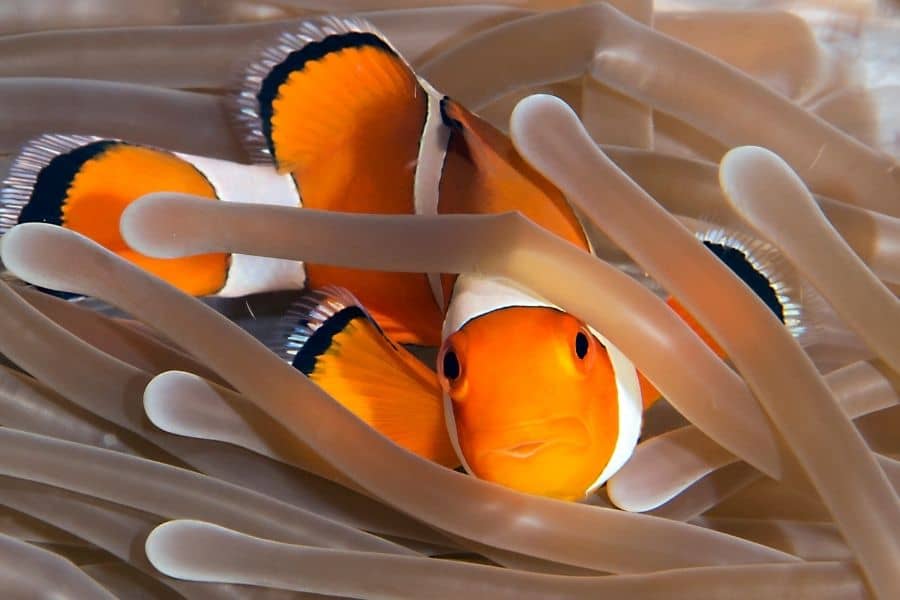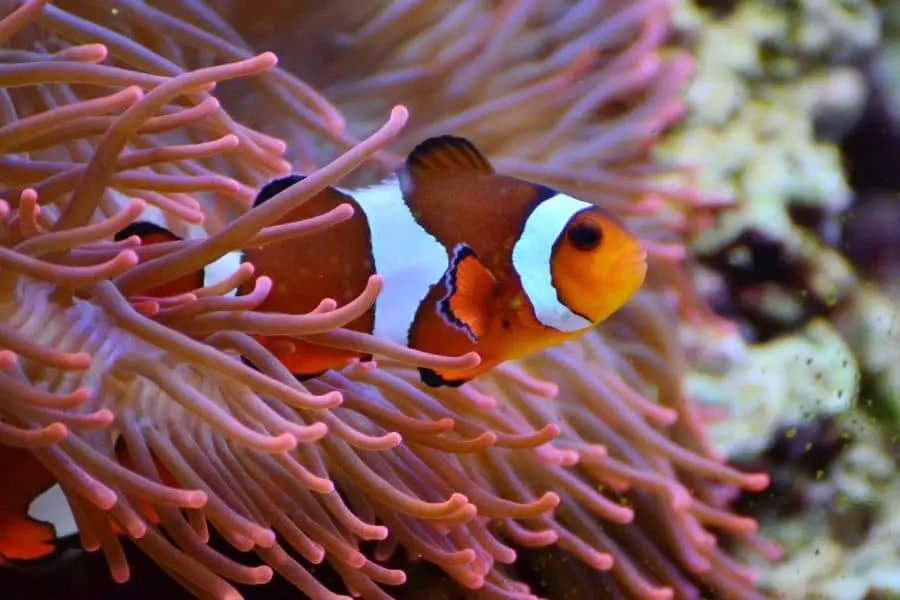Clownfish are also recognized as anemonefish because they make their homes in anemones in the sea. There are about 30 clownfish species, and each species has different preferences in anemones.
But, do clownfish need anemones to live? The short answer is No. They can survive without anemones if there’s none available. However, keeping anemones and clownfish together has many benefits to each other species. Let’s talk about them in this article.

How Do Clownfish Benefit from Sea Anemones
Jump To
- 1 How Do Clownfish Benefit from Sea Anemones
- 2 Do Clownfish Need Anemones to Breed
- 3 Can Clownfish Live Without Anemone in the Aquarium
- 4 Do Clownfish Need Anemones to Breed
- 5 Do Clownfish Help Anemones
- 6 How Many Clownfish Live In One Anemone
- 7 What Are the Best Anemones for Clownfish
- 8 What Anemones Do Clownfish Prefer?
- 9 Related Questions
- 10 Source
As I have said before, Clownfish use anemones as their home, their shelter. But that’s not all they get from anemones. The Anemone provides protection to clownfish from their predators.
Sea anemone tentacles can deliver a toxic sting, which can paralyze marine creatures, including small fish and larger species.
Clownfish are immune to this sting; hence, they immediately swim into the Anemone and hide within the tentacles when predators come too close.
In addition to shelter and protection, Clownfish also benefit from some food from anemones.
Clownfish often eat dead tentacles of anemones and also scavenge the leftover food of anemones.
It’s not only the clownfish that benefits from anemones. Anemones also provide protection to clownfish eggs. I will explain how they do it in a moment.
Do Clownfish Need Anemones to Breed
Clownfish don’t need anemones to breed. But, they use anemones to their advantage when reproducing.
Clownfish usually use a rock or piece of coral near Anemone to lay their eggs because their eggs get protection from Anemone if predators try to eat the eggs.
When a fish goes near the Anemone, it tries to catch the fish and secrete their toxin to paralyze their prey.
As the Anemone eats the fish that goes near clownfish eggs, the eggs get the necessary protection until they hatch.
Can Clownfish Live Without Anemone in the Aquarium
Yes. Clownfish can live without Anemone in the Aquarium. As we don’t keep predator fish with clownfish in aquariums, they don’t need the protection they get from Anemone.
You can provide them shelter with some coral reefs, rocks, and caves. Further, they get enough food from the aquarium owner constantly.
Clownfish will do fine without an Anemone when you fulfill the necessary requirements inside the Aquarium.

Wild Clownfish
Wild clownfish used to live in their natural habitats, which are anemones. If you catch them and put them in a tank, they get stressed. The increased stress level may be fatal to the fish because their immunity drops because of the stress.
You can avoid this by providing them with their natural habitats in your Aquarium. To do that, you need an Anemone in a reef aquarium.
Additionally, you should feed them with live fish for some time until they get used to the new environment.
So, wild clownfish cannot live without Anemone in the Aquarium until they get accustomed to the aquarium life.
Tank Raised
On the other hand, tank-raised clownfish used to live in aquariums since their birth. So, they can adjust to changes in aquariums more quickly than wild-caught clownfish.
They are usually hardier than wild-caught clownfish and can live without Anemone in the Aquarium.
Do Clownfish Need Anemones to Breed
Wild clownfish prefer anemones in the sea because of the protection they and their eggs get from anemones.
But, that doesn’t mean that Anemone is a must for their reproduction. Clownfish can breed without living in an anemone, just that their survival rate decreases without the presence of anemones.
Tank-bred clownfish just do fine without anemones. They can live as well as breed without an anemone.
Clownfish who live in anemones are more territorial and aggressive than tank-bred clownfish. Therefore, wild clownfish usually fight to the death to secure their territory.
On the other hand, Clownfish who are captive-bred don’t have this aggression issue because breeders raise them in an environment without anemones.
They are usually friendly with other fish, including clownfish. As they are grown in tanks without anemones, tank-raised clownfish can breed without anemones.
Do Clownfish Help Anemones
Yes. Clownfish and anemones have a symbiosis relationship that each species benefits from the other.
Clownfish are usually brightly colored, which makes them more attractive for predator fish. When predator fish swim to the clownfish to catch them and eat, clownfish run away from the fish to the Anemone.
Anemone takes this chance, catches and eats them when the fish goes near the Anemone.
By chasing away anemone predators like butterfly fish, clownfish help anemones providing anemone protection in return. Clownfish also fertilize anemones with their ammonia-rich waste.
Clownfish help anemones in another way by helping anemones to breathe at night. Anemones rely on sea currents to bring in oxygen and nutrients.
Due to slower current movement at night, anemones struggle to breathe at night.
When a clownfish lives inside an anemone, the fish actively moves and opens up the tentacles while encouraging water to flow between them.
This fish’s fanatic dance causes the water to flow and aerate both of them, making them absorb 40% more oxygen at night together.
Scientists believe that there are more secrets to be revealed between them, and they think there are more personal benefits they share in their mutual relationship.
How Many Clownfish Live In One Anemone
Clownfish are territorial species and very aggressive if they have limited space and shelter.
If you introduce an anemone to your Aquarium with two or more Clownfish, only one will claim it and make its territory.
Usually, that will be the dominant one, which is the female clownfish. All others will not bother going near the Anemone; unless they are a paired couple.
Related : How Big Do Clownfish Get? Size Comparison on Each Species.
Related : Can Clownfish Change Gender? Interesting Facts You Must Know
Must See : How Much Do Clownfish Cost By Type? Must-Know Things
What Are the Best Anemones for Clownfish
As I said before, there are about 30 clownfish species, and each clownfish species hosts different types of anemones.
Although there are more than 1000 anemone species that can be found in the sea, only ten anemone species will host clownfish.
All other anemone types are known to prey on clownfish like most other fish species. Below list are the ten types of anemones and their host clownfish species.
Related: Sea bunny | Facts You Must Know
Carpet Sea Anemone (Cryptodendrum adhaesivum)
Clownfish Types Prefer Carpet Sea Anemone:
- Clark’s Yellowtail (Amphiprion clarkii) Clownfish
Bubble Tip Anemone (Entacmaea quadricolor)
Clownfish Types Prefer Bubble Tip Anemone:
- Cinnamon, Red, and Black (Amphiprion melanopus) Clownfish
- Clark’s Yellowtail (Amphiprion clarkii) Clownfish
- Maroon, Spinecheek, White-Stripe, Gold-Stripe (Premnas biaculeatus) Clownfish
- Red Saddleback, Fire (Amphiprion ephippium)
- Skunk (Amphiprion akallopisos) Clownfish
- Tomato, Red (Amphiprion frenatus) Clownfish
- Ocellaris, False Percula (Amphiprion ocellaris) Clownfish
- Percula, True Percula, Clown Anemonefish (Amphiprion percula) Clownfish
Beaded (Aurora) Sea Anemone (Heteractis aurora)
Clownfish Types Prefer Beaded (Aurora) Sea Anemone:
- Clark’s Yellowtail (Amphiprion clarkii) Clownfish
Leathery (Sebae) Sea Anemone (Heteractis crispa)
Clownfish Types Prefer Leathery (Sebae) Sea Anemone:
- Cinnamon, Red, and Black (Amphiprion melanopus) Clownfish
- Clark’s Yellowtail (Amphiprion clarkii) Clownfish
- Orange Skunk (Amphiprion sandaracinos) Clownfish
- Percula, True Percula, Clown Anemonefish (Amphiprion percula) Clownfish
- Pink Skunk Clownfish (Amphiprion perideraion) Clownfish
- Red Saddleback, Fire (Amphiprion ephippium)
- Saddleback (Amphiprion polymnus) Clownfish
- Tomato, Red (Amphiprion frenatus) Clownfish
Magnificent Sea Anemone (H. Magnifica)
Clownfish Types Prefer Magnificent Sea Anemone:
- Clark’s Yellowtail (Amphiprion clarkii) Clownfish
- Ocellaris, False Percula (Amphiprion ocellaris) Clownfish
- Percula, True Percula, Clown Anemonefish (Amphiprion percula) Clownfish
- Pink Skunk Clownfish (Amphiprion perideraion) Clownfish
- Skunk (Amphiprion akallopisos) Clownfish
Sebae Sea Anemone (H. malu)
Clownfish Types Prefer Sebae Sea Anemone:
- Clark’s Yellowtail (Amphiprion clarkii) Clownfish
Corkscrew (Long Tentacle) Sea Anemone (Macrodactyla doreensis)
Clownfish Types Prefer Corkscrew (Long Tentacle) Sea Anemone:
- Clark’s Yellowtail (Amphiprion clarkii) Clownfish
- Maroon, Spinecheek, White-Stripe, Gold-Stripe (Premnas biaculeatus) Clownfish
- Pink Skunk Clownfish (Amphiprion perideraion) Clownfish
Giant Carpet Sea Anemone (Stichodactyla gigantea)
Clownfish Types Prefer Giant Carpet Sea Anemone:
- Clark’s Yellowtail (Amphiprion clarkii) Clownfish
- Ocellaris, False Percula (Amphiprion ocellaris) Clownfish
- Percula, True Percula, Clown Anemonefish (Amphiprion percula) Clownfish
- Pink Skunk Clownfish (Amphiprion perideraion) Clownfish
Haddon’s (Saddleback Carpet) Sea Anemone (S. haddoni)
Clownfish Types Prefer Haddon’s (Saddleback Carpet) Sea Anemone:
- Clark’s Yellowtail (Amphiprion clarkii) Clownfish
- Ocellaris, False Percula (Amphiprion ocellaris) Clownfish
- Saddleback (Amphiprion polymnus) Clownfish
- Sebae, Seba’s (Amphiprion sebae) Clownfish
Merten’s Carpet Sea Anemone (S. mertensii)
Clownfish Types Prefer Merten’s Carpet Sea Anemone:
- Clark’s Yellowtail (Amphiprion clarkii) Clownfish
- Orange Skunk (Amphiprion sandaracinos) Clownfish
- Percula, True Percula, Clown Anemonefish (Amphiprion percula) Clownfish
- Skunk (Amphiprion akallopisos) Clownfish
What Anemones Do Clownfish Prefer?
Almost all clownfish types prefer Leathery (Sebae) Sea Anemone (Heteractis crispa) and Bubble Tip Anemone (Entacmaea quadricolor).
Among these anemone types, bubble tip anemone is considered beginner-friendly because it is a hardy anemone type.
They are attractive as well. So, if you are a beginner aquarist and planning to keep an anemone with your Clownfish, the best option for you is Bubble Tip Anemone.
Related Questions
Easiest Anemone for Clownfish
Easiest Anemone will differ for each clownfish species. As I have listed above, each clownfish species prefers to host on different anemone types.
So, if you plan to keep an anemone in your Aquarium, check the preferred Anemone for your clownfish species.
Bubble Tip Anemone is considered the easiest Anemone to keep in an aquarium, and most clownfish species will accept BTA as their host.
However, some clownfish are very picky, so they may not choose BTA as their host.
Do Ocellaris Clownfish Need Anemones
Clownfish do not require host anemone to survive or thrive. Living along with Anemone has many benefits for clownfish at sea, but there’s no need for that protection, shelter, and food they get from Anemone in an aquarium.
Hence, they can thrive well in an aquarium without an anemone. However, wild clownfish may need Anemone for some time because they are used to living in anemones.
Do Clownfish Clean Anemones?
Yes. Clownfish clean anemones by eating the algae and other food leftovers stuck inside anemones. They also eat dead anemone tentacles making them excellent partners.
Source
Roux, N., Lami, R., Salis, P., Magré, K., Romans, P., Masanet, P., Lecchini, D. and Laudet, V., 2019. Sea anemone and clownfish microbiota diversity and variation during the initial steps of symbiosis. Scientific reports, 9(1), pp.1-13.
Titus, B.M., Benedict, C., Laroche, R., Gusmão, L.C., Van Deusen, V., Chiodo, T., Meyer, C.P., Berumen, M.L., Bartholomew, A., Yanagi, K. and Reimer, J.D., 2019. Phylogenetic relationships among the clownfish-hosting sea anemones. Molecular phylogenetics and evolution, 139, p.106526.
